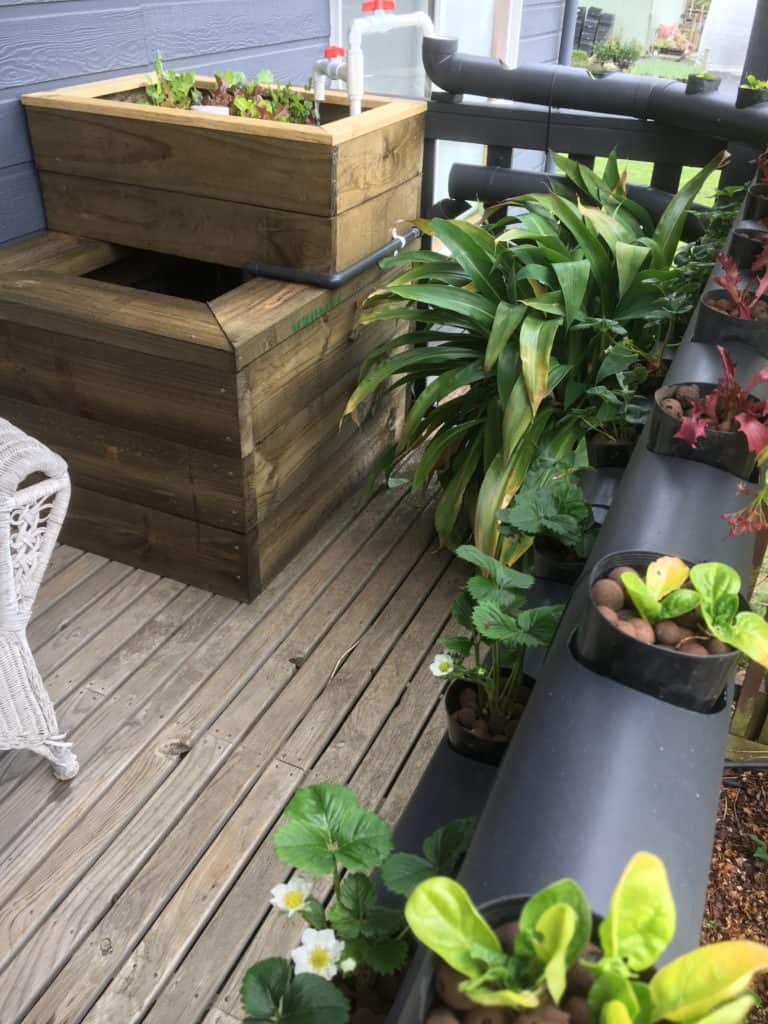
Do it yourself-Patio Aquaponic System
This is an article about our patio aquaponic system. We are very much beginners and learning as we go. We decided to try this DIY patio system. It’s nice and small and hopefully we can learn a lot before we try a much larger system in the backyard.
This system only took a weekend to set up, then a month to cycle the tank, after which we added the fish and plants.
- The fish tank holds 220litres (58gal).
- The grow area on top holds about 50 litres (13gal).
- The pipes are 90mm (3.5″) stormwater pipe, with holes cut in the top to hold a small 75mm (3″) pot.
- We clad the tank and grow area with wooden sleepers.
- We use a 24volt 1000L (264gal) submersible pond pump
- The pipes from the pump are 20mm (0.8″) with 2 valve fittings to regulate flow.
- There is a bell siphon made from some assorted pipe sizes.
This little system cost us about $250 Australian dollars in materials.
What is aquaponics?
Aquaponics is the merging of two types of farming. Aquaculture (which is the farming of fish) and Hydroponics (which is the growing of plants in nutrient rich water).
What happens in an aquaponic system is the fish produce ammonia, which through a process called the nitrogen cycle gets transformed into nitrate. Nitrate is an essential nutrient for plant growth.
Fish need nice clean water to survive in captivity, through the nitrogen cycle transforming ammonia into nitrite then into nitrate this helps maintain water health. Then by adding the plants, which remove the nitrate as their source of food, this closed system begins a natural symbiotic relationship.
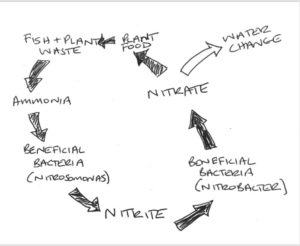
The above picture shows how the nitrogen cycle works. When we keep fish in an aquarium to remove the excess nitrate we do water changes. In the Aquaponics system the plants remove the nitrate for us.
Of course, you’ll need to find the right balance of fish and plants. We are hoping this little project will teach us a lot so we can create a bigger system.
Why we decided to try aquaponics
I love the sound of running water, I love watching fish, Petra loves growing food. With an aquaponics system everyones a winner.
I was planning on building a patio pond with a bog filter. The bog filter works by the plants removing the excess nitrate from the water and providing great habitat for the beneficial bacteria.
It was while I was researching design ideas for the bog filter that I stumbled upon aquaponics.
Very quickly I was consuming any information I could find on peoples home aquaponics systems.
So promptly my plans changed I changed, and i decided that the patio pond with bog filter would become a patio aquaponic system.
It just seems to good to be true, so we’ve decided we have to try it!
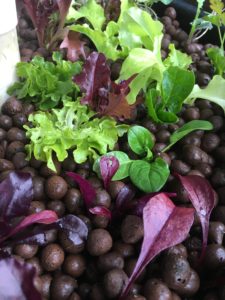
Leafy greens in grow bed
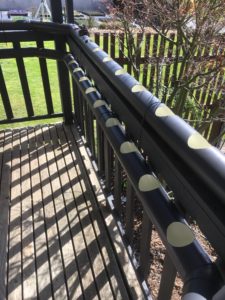
Pipes running along the verandah
System design
The system we have built is very simple. It consists of a 220 Litre (58 gal) Fish tank. We didn’t use an actual fish tank it’s just a food grade plastic tub that holds water.
There is a smaller 50 litre (13gal) plastic tub that sits above the larger fish tank. Again this tub is made from food safe plastic. This tub is used to grow vegetables, it’s called a grow bed.
We have 90mm (3.5″) stormwater pipes that we have run along the railing of the verandah. We’ve cut holes into the top of the pipe that allows a 75mm (3″) pot to sit inside the pipe. We felt this was a great way to utilise the space we were working with and allow us to grow more plants in the system. Plus this end of our patio was never fully utilized and now we feel it’s a perfect space for this.
The water running through the stormwater pipes is in a constant loop and returns to the fish tank tub. It drops about 30cm (1ft) into the tub, this helps add oxygen to the water. Fish need oxygen in the water.
We use a 24volt submersible pond pump which can pump 1000 litres (264gal) per hour. It pumps the water up into the grow bed and into the stormwater pipes. We have used valves to regulate the flow into the different parts of the system
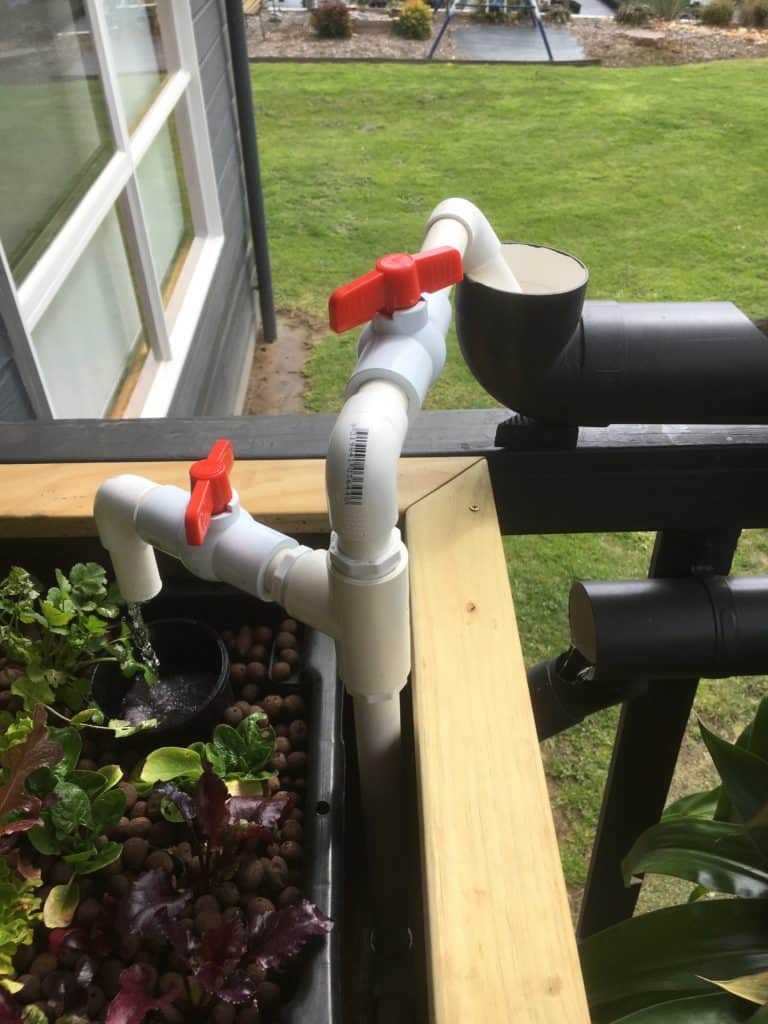
Valves on patio aquaponic system
It’s important that the water in the fish tank is “turned over” at least once an hour. The pump we have can pump 1000 litres (264gal) an hour, which may seem like over kill.
Keep in mind that as the water is pumped up to the desired height the flow rate decreases. We figured it’s much better to have an oversized pump than undersized.
We built some boxes out of timber to house the plastic tubs, which makes the system a little more aesthetically pleasing. We also painted most of the exposed pipework to blend it into the railing.
Grow bed and bell siphon
If this system was going to be a simple patio pond with bog filter, the smaller tub on top of the fish tank would have housed water loving plants. That means that the tub could be constantly full of water.
To make the change to being able to grow vegetables in this tub, the water had to be able to drain away. Bog plants don’t require much oxygen, but most other plants do.
The grow bed needs to be able to flood and drain. The nutrient rich water slowly fills up the grow bed once it reaches a level about 1-2″ from the top of the growing media it then begins to escape.
This is where the bell siphon comes in. For me the bell siphon is one of the coolest things I’ve ever built. What the bell siphon does, is create a siphon that drains all the water out of the grow bed.
The beauty of this device is that it doesn’t require any other energy input, just some fine tuning of the water flow into the system.
Below is a video from Rob’s backyard and aquaponics youtube channel. I’ve found his channel incredibly valuable. Check it out.
I had to make a slight modification to the siphon in this video as I couldn’t get the siphon to stop.
By having a tube run up to the top of the bell part it allowed a little bit more air in and seems to have fixed my problem.
To make our bell siphon
- We first cut a hole in the bottom of the grow bed tub.
- We then used a 25mm (1″) bulkhead fitting to create a watertight seal
- We used a 25mm (1″) piece of pipe as the stand pipe (this sets the maximum water level). This we cut at 235mm (9″). With the bulkhead fitting this set our maximum water level at 250mm (10″) Remember, we want 1-2″ of growing media above the maximum water level.
- The bell that sits over the stand pipe is a 50mm (2″) pipe with a watertight cap on the end. At the bottom of the pipe are multiple holes drilled in to allow water and air in. As mentioned we had to add a tube, to allow more air into the bell to stop the siphon (see below picture)
- The standpipe and bell are housed within a 90mm (3.5″) stormwater pipe (this is called the shroud). When we put the bulkhead in we had a cap that this pipe could sit inside, this locks it securely in place. The shroud has multiple holes and slits in it to allow water in unobstructed.
- Under the grow bed connected to the bulkhead we have a 90 degree elbow join, this seems to help initiate the siphon by allowing air to get trapped in the stand pipe. Once the air is trapped all the water gets sucked out. Once the water drains out air gets sucked back in and the grow bed begins to fill, starting the process anew.
If you don’t feel like making your own bell siphon, you might prefer to purchase a ready made one on ebay. Click here to check some out.
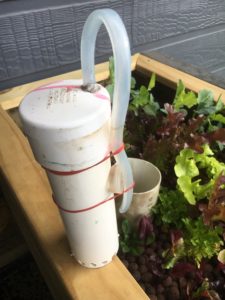
Modified bell siphon
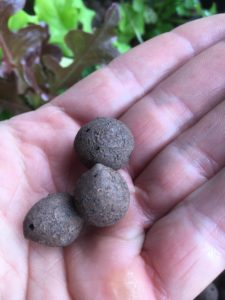
Aquaponic clayballs
What to grow the vegetables in
In this system we used some aquaponic clayballs. These are widely used in hydroponics and aquaponics.
There are a few things to consider when deciding on a medium to grow the vegetables in.
- The medium should be pH neutral.
- It should have a reasonable size so it cannot fit through the shroud, but also to allow plenty of surface area for beneficial bacteria to colonise.
- Should be easy to work with, something lightweight, avoid sharp materials.
- Be free of limestone. To test this put some of the gravel in a cup of vinegar, if the gravel starts to fizz there is limestone. Limestone will alter the pH.
- Don’t use media that will decompose over time. It will just get messy and clog up the system.
We were lucky we found a fellow who was about to travel around Australia and he sold us all his clay-balls at a very good price. The balls are great, they are light weight, rounded and very easy to work with. Keep your eyes out on social media or ebay/gumtree sites to see if you can find a bargain!
The depth of the growing media should be about 300mm (12″) and this is what we have done.
Even the 75mm (3″) pots are filled with the clay-balls. There is no soil in the system at all.
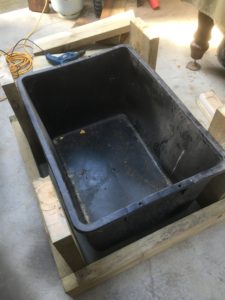
Patio aquaponic system build
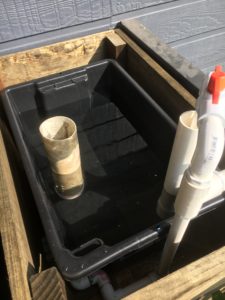
Testing before adding media
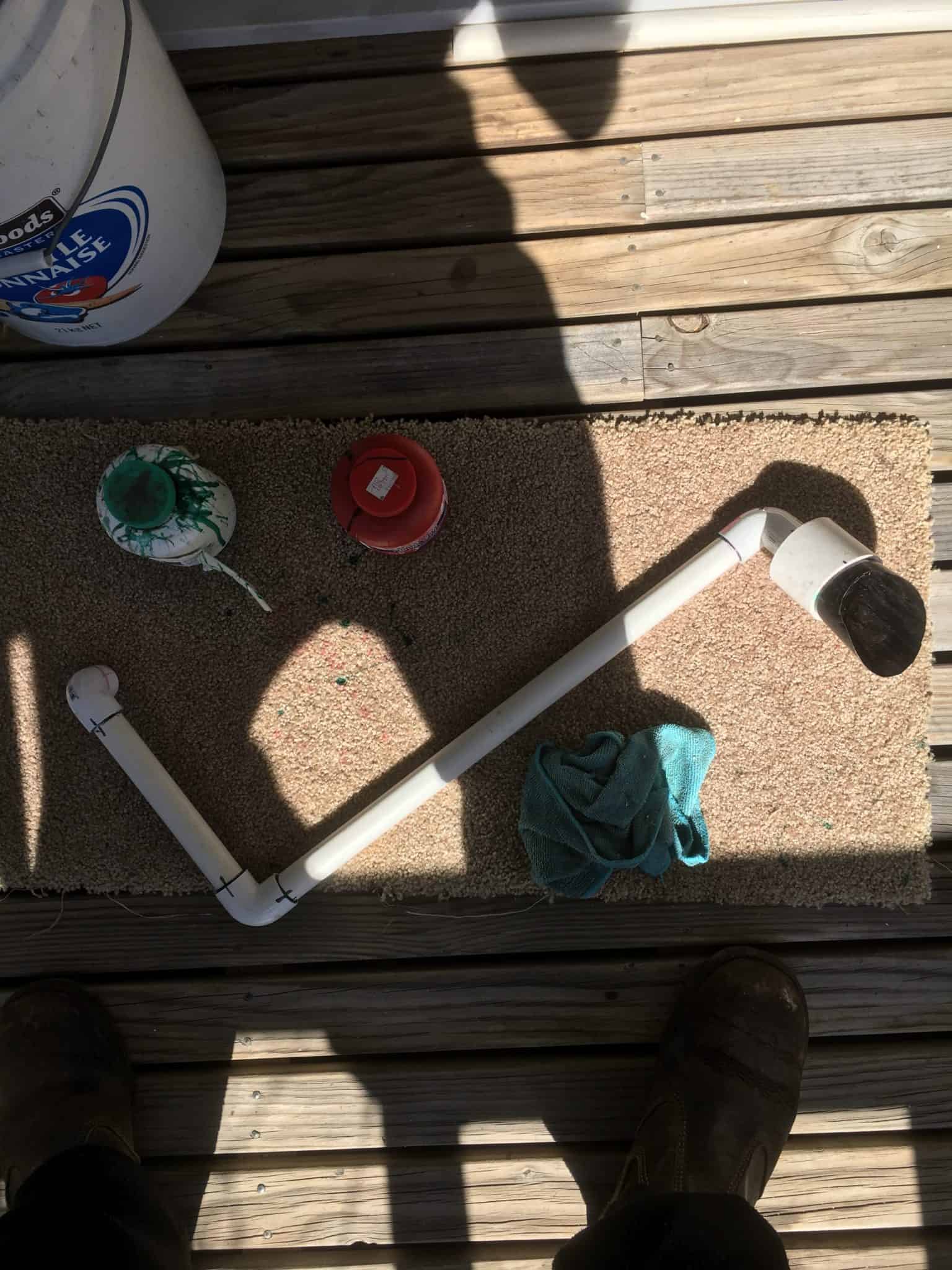
Glueing pipework
Plants we are growing
Because this is a trial system at the moment, we want to try the 3 main ways of aquaponic growing.
Firstly is having a grow bed, which ebbs and flows, in our bed we are growing lettuce, beetroot, kale, baby spinach and some herbs.
Over in the stormwater pipe we have lettuce on the top. Here the water is deeper so its more like what’s called a raft system or Deep Water Culture (DWC).
Below the lettuce the pipe has more of an angle so the water is much faster flowing and shallower. This is trialling whats called Nutrient Film technique (NFT) and here we are growing strawberries.
Here’s hoping it all works out cause we are really excited about the potential of this kind of food growing. It’s not just the vegetables, if this works and we decide to create a bigger system we will then be able to grow fish to eat as well:)
Below is a very short video showing the system in it’s infancy. I apologise for all my umming I’m very camera shy. We will keep updating the systems progress over time.
Thanks for reading 🙂
Short video showing our first aquaponic attempt. At the time of recording the system is only 5 weeks old and the plants just went in.
We will keep updating the progress of this system.
